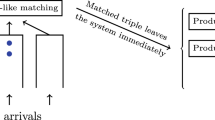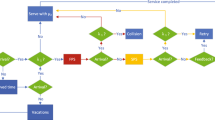Abstract
Heavy traffic limits for multiclass queueing networks are a topic of continuing interest. Presently, the class of networks for which these limits have been rigorously derived is restricted. An important ingredient in such work is the demonstration of state space collapse. Here, we demonstrate state space collapse for two families of networks, first-in first-out (FIFO) queueing networks of Kelly type and head-of-the-line proportional processor sharing (HLPPS) queueing networks. We then apply our techniques to more general networks. To demonstrate state space collapse for FIFO networks of Kelly type and HLPPS networks, we employ law of large number estimates to show a form of compactness for appropriately scaled solutions. The limits of these solutions are next shown to satisfy fluid model equations corresponding to the above queueing networks. Results from Bramson [4,5] on the asymptotic behavior of these limits then imply state space collapse. The desired heavy traffic limits for FIFO networks of Kelly type and HLPPS networks follow from this and the general criteria set forth in the companion paper Williams [41]. State space collapse and the ensuing heavy traffic limits also hold for more general queueing networks, provided the solutions of their fluid model equations converge. Partial results are given for such networks, which include the static priority disciplines.
Similar content being viewed by others
References
F. Baskett, K.M. Chandy, R.R. Muntz and F.G. Palacios, Open, closed and mixed networks of queues with different classes of customers, J. ACM 22 (1975) 248-260.
A. Bernard and A. El Kharroubi, Régulation de processus dans le premier orthant de Rn, Stochastics and Stochastics Rep. 34 (1991) 149-167.
M. Bramson, Instability of FIFO queueing networks, Ann. Appl. Probab. 4 (1994) 414-431.
M. Bramson, Convergence to equilibria for fluid models of FIFO queueing networks, Queueing Systems 22 (1996) 5-45.
M. Bramson, Convergence to equilibria for fluid models of head-of-the-line proportional processor sharing queueing networks, Queueing Systems 23 (1997) 1-26.
M. Bramson, Stability of two families of queueing networks and a discussion of fluid limits, Queueing Systems 28 (1998) 7-31.
M. Bramson, Nonuniqueness of FIFO fluid models of Kelly type (1998), in preparation.
H. Chen and A. Mandelbaum, Discrete flow networks: Diffusion approximations and bottlenecks, Ann. Probab. 19 (1991) 1463-1519.
H. Chen and H. Zhang, Diffusion approximations for re-entrant lines with a first-buffer-first-served priority discipline, Queueing Systems 23 (1996) 177-195.
H. Chen and H. Zhang, Diffusion approximations for some multiclass queueing networks with FIFO service disciplines, preprint.
J. Dai, On positive Harris recurrence of multiclass queueing networks: a unified approach via fluid models, Ann. Appl. Probab. 5 (1995) 49-77.
J. Dai and J.M. Harrison, The QNET method for two-moment analysis of closed manufacturing systems, Ann. Appl. Probab. 3 (1993) 968-1012.
J. Dai and T. Kurtz, A multiclass station with Markovian feedback in heavy traffic, Math. Oper. Res. 20 (1995) 721-742.
J. Dai and V. Nguyen, On the convergence of multiclass queueing networks in heavy traffic, Ann. Appl. Probab. 4 (1994) 26-42.
J. Dai and Y. Wang, Nonexistence of Brownian models for certain multiclass queueing networks, Queueing Systems 13 (1993) 41-46.
M.H.A. Davis, Piecewise deterministic Markov processes: A general class of nondiffusion stochastic models, J. Roy. Statist. Soc. Ser. B 46 (1984) 353-388.
V. Dumas, Instability cycles in fluid Bramson networks, IEEE Trans. Automat. Control (1998), to appear.
J.M. Harrison, The diffusion approximation for tandem queues in heavy traffic, Adv. in Appl. Probab. 10 (1978) 886-905.
J.M. Harrison, Brownian models of queueing networks with heterogeneous customer populations, in: Stochastic Differential Systems, Stochastic Control Theory and their Applications, IMA Volumes in Mathematics and its Applications 10 (Springer, New York, 1988) pp. 147-186.
J.M. Harrison, Balanced fluid models of multiclass queueing networks: A heavy traffic conjecture, in: Stochastic Networks, IMA Volumes in Mathematics and its Applications 71 (Springer, New York, 1995) pp. 1-20.
J.M. Harrison and V. Nguyen, The QNET method for two-moment analysis of open queueing networks, Queueing Systems 6 (1990) 1-32.
J.M. Harrison and V. Nguyen, Brownian models of multiclass queueing networks: Current status and open problems, Queueing Systems 13 (1993) 5-40.
J.M. Harrison and R.J. Williams, Brownian models of feedforward queueing networks: Quasireversibility and product form solutions, Ann. Appl. Probab. 2 (1992) 263-293.
D.L. Iglehart and W. Whitt, Multiple channel queues in heavy traffic I, Adv. in Appl. Probab. 2 (1970) 150-177.
D.L. Iglehart and W. Whitt, Multiple channel queues in heavy traffic II, Adv. in Appl. Probab. 2 (1970) 355-364.
D.P. Johnson, Diffusion approximations for optimal filtering of jump processes and for queueing networks, Ph.D. thesis, University of Wisconsin (1983).
F.P. Kelly, Networks of queues with customers of different types, J. Appl. Probab. 12 (1975) 542-554.
F.P. Kelly, Reversibility and Stochastic Networks (Wiley, New York, 1979).
S.H. Lu and P.R. Kumar, Distributed scheduling based on due dates and buffer priorities, IEEE Trans. Automat. Control 36 (1991) 1406-1416.
W.P. Peterson, Diffusion approximations for networks of queues with multiple customer types, Math. Oper. Res. 9 (1991) 90-118.
M.I. Reiman, Open queueing networks in heavy traffic, Math. Oper. Res. 9 (1984) 441-458.
M.I. Reiman, Some diffusion approximations with state space collapse, in: Proc. of the Internat. Seminar on Modeling and Performance Evaluation Methodology, Lecture Notes in Control and Informational Sciences, eds. F. Baccelli and G. Fayolle (Springer, New York, 1984) pp. 209-240.
M.I. Reiman, A multiclass feedback queue in heavy traffic, Adv. in Appl. Probab. 20 (1988) 179-207.
M.I. Reiman and R.J. Williams, A boundary property of semimartingale reflecting Brownian motions, Probab. Theory Related Fields 77 (1988) 87-97. (Correction 80 (1989) 633.)
S. Rybko and A. Stolyar, Ergodicity of stochastic processes that describe the functioning of open queueing networks, Problems Inform. Transmission 28 (1992) 3-26 (in Russian).
T.I. Seidman, “First come, first served” can be unstable! IEEE Trans. Automat. Control 39 (1994) 2166-2171.
A. Stolyar, On the stability of multiclass queueing networks, in: Proc. of the 2nd Conf. on Telecommunication Systems — Modeling and Analysis, Nashville (1994) pp. 1020-1028.
W. Whitt, Weak convergence theorems for priority queues: preemptive-resume discipline, J. Appl. Probab. 8 (1971) 74-94.
W. Whitt, Large fluctuations in a deterministic multiclass network of queues, Managm. Sci. 39 (1993) 1020-1028.
R.J. Williams, On the approximation of queueing networks in heavy traffic, in: Stochastic Networks, Theory and Applications, Royal Statistical Society Lecture Note Series, eds. F.P. Kelly, S. Zachary and I. Ziedlins (Clarendon Press, Oxford, 1996) pp. 35-56.
R.J. Williams, Diffusion approximations for open multiclass queueing networks: sufficient conditions involving state space collapse, Queueing Systems 30 (1998) 27-88.
Author information
Authors and Affiliations
Rights and permissions
About this article
Cite this article
Bramson, M. State space collapse with application to heavy traffic limits for multiclass queueing networks. Queueing Systems 30, 89–140 (1998). https://doi.org/10.1023/A:1019160803783
Issue Date:
DOI: https://doi.org/10.1023/A:1019160803783




